707 Advanced Workout for EZ Swimmer - Seated Balance - Balance Ball for the Swimming Pool
Last week I attended a water aerobics
class at the YMCA and the majority of the class was one exercise - the
Seated Balance™ with the EZ Swimmer. Imagine a balance ball in the
water?! Fun and safe and effective too! It was a great exercise class!
Diane instructed the class and had exercise after exercise with the EZ Swimmer®. The one exercise I was surprised I could do was knee raises. Pulling myself up on land and doing knee raises as shown in the video at the right is not a possibility for me. Performing knee raises in the water on the EZ Swimmer® in the Seated Balance position was difficult but fun and effective.
Swim Board - Work Your Core with the Seated Balance
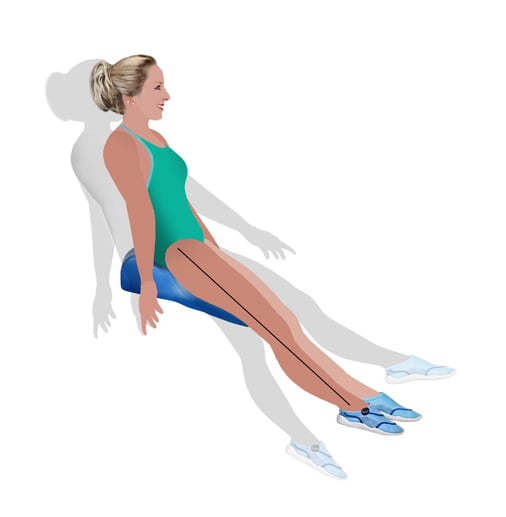
Knee Raise Exercise - Land Version
The History of the Balance Ball and Bosu
"The history of the balance ball and how it came to acquire its name as the "Swiss Ball" is fascinating. The balance ball was actually invented by an Italian man, a toymaker by trade, named Aquilino Cosani. He invented it in the 1960s. The "toy" did not come into fame until Swiss physical therapists incorporated the new invention into their therapy programs, thus the name the "Swiss Ball" not the "Italian Ball".
In the 1980s, the balance ball was introduced into the United State and has since become a fundamental fitness tool that is present at every
gym and health club in the United States.
The Toy Turned Into a Fitness Tool
The Swiss Ball or balance ball as commonly referred to is an exercise or stability ball, a fitness tool that is a large, inflatable ball designed well for various exercises to change the core. With 640 muscles in the human body, the exercises that make the most sense are functional exercises that challenge and target tone in more than one area of the body."
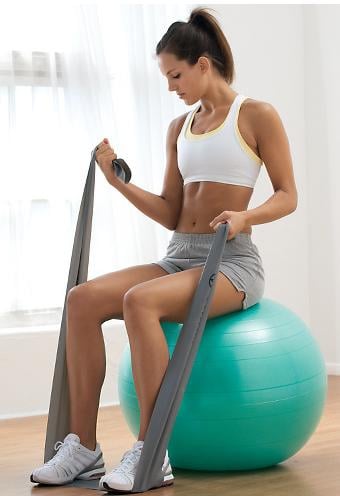
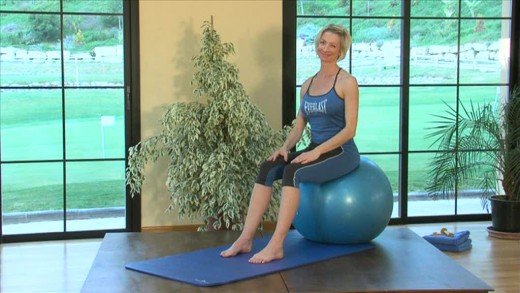
EZ Swimmer - Balance Ball for the Water
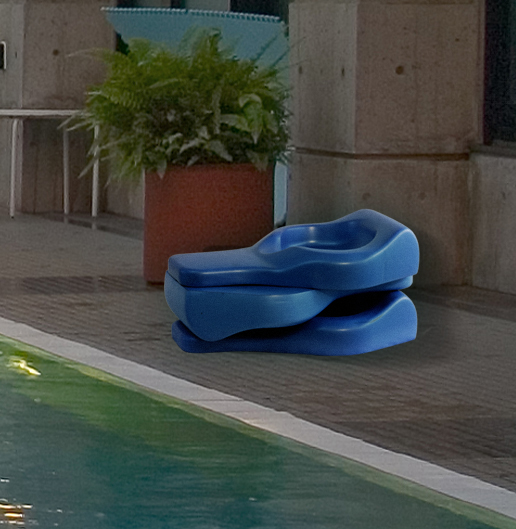
Side Note: While I am the inventor of the EZ Swimmer®, it is my clients and the instructors that I learn from. The exercises are endless and fun! Diane is a Master Instructor with years of personal training. Her knowledge is only surpassed by her compassion and understanding and quick wit!
The scissor movement with the Seated Balance often I do with my class but I always coach them to hold on to the fitness tool. As Diane so aptly describes it, place your thumbs inside and hold on for the Seated Balance ride! With this exercise I feel my legs and my core working together. And while many of my clients can do the scissors with the Seated Balance with the thumbs or holding on to the fitness tool, I usually find myself "bucked" in this maneuver.
The bobbing movement with the Seated Balance™ is almost smoothing for me. Taking it up another level with the arm circles is wonderful for the lady who is currently fighting two frozen shoulders. Yes, frozen shoulders plague women ages 40-60 and I happen to be one of the many statistics. The water exercises for the shoulder on the EZ Swimmer's Seated Balance are great for my range of motion.
My favorite exercise on the Seated Balance™ may very well be the hummingbird - where the hands are opened wide and the arms close and open to build resistance for the upper body.
The soaring eagle is essentially the hummingbird movement with the hands parallel to the swimming pool floor for less resistance.
The balance ball was a fitness tool that I did not understand when it was first introduced. The story goes that many fitness professionals did not understand this tool until a Swiss physical therapist included the "toy" in their training programs. From Italy to Switzerland to the United States - the world is a great place with lots of similarities!
While the possible exercises may be endless and only limited by our imagination. The Seated Balance for the water is a remarkable tool. Not necessarily a therapy tool, more of a fitness tool for those who are healthy and want a challenge. The Seated Balance is considered an advanced exercise. Do not try the Seated Balance unless you have properly trained your abs. The Seated Balance will TELL you! Sadly clients who have had cesareans even though they are very fit and athletic have experience difficulties. I know as a marketing person I am not supposed to tell you the pitfall but as a truthful inventor, I feel it is my duty not to mislead you. Most people conquer the Seated Balance™ well, not all - it is not for everyone.
Bucked by the Bronco
At one time or another all of us have been "bucked" by what we have nicked the bronco. You see the Seated Balance is similar to riding a horse - with the exception if you are bucked - it is only in the water - you are completely safe and comfortable.
If you are afraid of water on your face, do not try the Seated Balance until you have full control with your core muscles. The Seated Balance is named an "advanced" exercise. It is not for everyone but it is for everyone to strive for at some point in the future. You will be amazed how quickly your core muscles adapt and how your balance improves.
Biggest Misconception - Seated Balance - Sit In It - NO - On Top!
The biggest misconception about the Seated Balance - is it won't fit my big butt! Not true! The seated balance is a balance ball in the water, even tiny 9 year old butts do not "fit"! The fitness tool is designed with ridges for us to sit on TOP not in! Remember for the balance ball we don't sit in it - we balance on top of the ball.
Sizing
On land the ball must be sized to properly accommodate our legs. In the water, the fitness tool is designed to float with your legs off the swimming pool floor once you are comfortable and stabilized. Sizing runs from 90 lbs and upward. The only part of our body that doesn't float is a our head. The sizing has been specifically engineered to be appropriate for all adults.
Safety - No Standing! Derriere Please - NO Feet!
As the inventor and former risk manager, I hate to see the tool misused. The Seated Balance was designed for the derriere not for the feet! You wouldn't stand on a barbell would you? Use the tool properly and it will serve you well in your fitness goals.
Keep you feet off the fitness tool! Please! For the respect of both the fitness tool and for your own safety.
Exercise for Core Strength - Golf
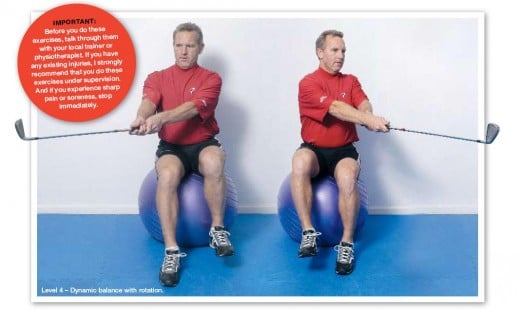
Training for Movement Not Target Toning
David Weck the inventor of the Bosu and perhaps the founding father of balance training here in the United States (the original inventor of the balance ball was an Italian who developed the agility ball as a toy) states that balance training is the foundation of a great exercise program both for himself and for his elite athletes. Essentially, the balance training is training for movement on three different planes (sagittal, traverse and coronal), verses target training and strengthening certain muscles and/or muscle groups.
Training on multiple planes is the ultimate goal of a fitness program. It is functional training that provides us the agility and flexibility that we need in every day movements in our lives and for elite athletes, it is functional training that gives them that special edge.
Great athletes are fluid. Their body moves and they are completely flexible. As we age, we stiffen, our agility and flexibility noticeably reduces. Study after study has confirmed this but more importantly, if you are over 40, you know firsthand. You don't need the research citations for proof - we are living proof!
Train for Movement Not Muscles
Training specific muscles combined with cardio and great diet is simply not enough. To take your exercise program to the next level, we need to also train for movement. Challenge the core, engage a complex set of muscles to response to life's complex set of physical and mental challenges.
"When discussing functional exercise or improvement of athletic abilities, it is commonly explained that you should train movement patterns rather than specific muscles. Admittedly, I will sometimes train or activate specific muscles, but it is for a particular corrective or rehabilitative reason. The majority of the time I will train movement patterns, because it has a greater effect on improving the golf swing. The important point to understand here is that when you focus on movement patterns you are in effect working to improve the nervous system, flexibility, strength, posture, balance and core function.
3 Planes of Movement
- Sagittal = forward or backward
- Frontal = side
to side (also known as the coronal plane)
- Transverse = rotational
Various Planes of the Human Body
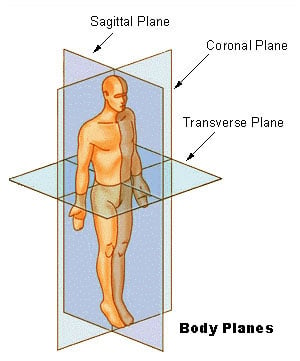
Three planes of functional movement
"The cutting edge techniques used in looking at the golf swing by golf professionals is the use of three dimensional motion analyses. When looking at the golf swing in this way the golf professional can better understand how the golfer generates and transfers speed throughout the swing. The Titleist Performance Institute calls this the Kinematic Sequence, and has done a great deal of work in applying it to golfers and diagnosing swing faults. Additionally, this motion analysis helps identify which plane of motion may be problematic in the golf swing."
Three Planes Needed in Golf
Whether your joy is found at the
golf or tennis court or simply feeling and looking great during your
daily routine, three planes of training is needed. The exercise experts
all agree on this fact. Flexibility and stretching are important too
but don't forget to include the balance training.
"When we move around, whether it is walking to work, playing with the kids or playing golf, we move in what is called planes of motion. There are 3 planes of motion that can be utilized with any activity. The sagittal plane is any movement that occurs in the direction of front to back. The descriptive terms of flexion and extension occur in the sagittal plane. Now, it is also important to understand that not only our bodies move in these planes but also our body parts. So nodding your head, raising your arm straight up, and bending forward happen in the sagittal plane. The second plane of motion is the frontal plane. This is any movement that occurs in the side to side direction. So side bending or leaning to the side, and performing a side lunge occurs in the frontal plane. The last plane of motion we use is the transverse plane. This is essentially the movement of rotation. Turning the head side to side and of course your golf swing occurs in the transverse plane."
The EZ Swimmer® - Water Aerobics Fitness Tool
Aquatic Resistance Training – At Its Best!
BUILD YOUR BICEPS
Tone your bicep muscles with aquatic push-ups. Use the natural buoyancy of water, the resistance of the EZ Swimmer™ combined with your own weight for comfortable and effective push-ups right in the water.
FLATTEN YOUR ABDOMINALS
Flatten your abdominal muscles with water crunches using the soft and comfortable EZ Swimmer™. This exercise combined with the buoyancy of the water prevents strain on your neck or back.
BUILD YOUR FLEXIBILITY/BALANCE
Tone your core muscles and challenge your balance with our Seated Balance by using the EZ Swimmer™ just as you would an exercise ball on land.
TARGET YOUR HEART RATE / INCREASE YOUR ENDURANCE
Tone your legs and increase your heart rate using the EZ Swimmer™ as your bicycle in the water with the Seated Balance Bicycle Movement. EZ Swimmer
EZ Swimmer - Balance Ball for the Water
The Seated Balance offers the same great qualities of the balance ball – only better – in the water!
EZ Swimmer® - A Balance Ball for the Water
Your body is the most miraculous invention on earth. Natural balance, for instance, is one of the many wonders of modern science. Scientists have proven that we can train the body to be more agile and to achieve greater balance through proper exercise.
Balance, besides being a basic skill, is needed in every sport. Balance also serves us well as we age by preventing injuries. As we age, we naturally lose this youthful gift of balance. However, if we remain active we can increase and/or maintain our agility or balance even as we age.
From golf to tennis to baseball to football, quickly and efficiently changing our center of gravity is critical to becoming or remaining a great athlete. Actively challenging your balance while in the water will improve your agility.
Instruction Tip: Keep your body in a diagonal position with your knees always lower than your waist. This position best engages your core muscles. As in weightlifting, proper form is key to engaging the correct muscle groups.
Proudly Made in the USA
Proper Posture Counts!
The foundation for a fit and healthy body is threefold - diet, exercise and good posture. Whenever we exercise, it is important to continuously review body alignment. Bad posture is often the root cause of many injuries. Injuries and the resulting pain cause us to become sedentary and often leads to weight gain and costly downtime from work and play. As my Grandfather’s doctor always advised, “You don’t see many old people who are overweight.” Be good to your body and it will be good to you for the rest of your life!
Perfect posture also allows you to breathe more effectively, keeps your internal organs in their proper place and helps you stay balanced. Always remember “Safety First”. An injury is not just painful but also time consuming. Keen attention to proper posture will save you both time and money. Good posture is a comfortable alignment or should form a straight line from your ears down to your feet; ears, shoulders, hips, knees and ankles all should be in alignment. When sitting, your ears, shoulders and hips should all be in alignment. You can lean back, just make sure you maintain that imaginery line between your ears and your hips. Your body has provided you with a natural curve at two spots, your neck and your back. Picture an imaginary vertical line and you will not only perform at your optimal level but also serve your body well by preventing injuries.
Seated Balance™ Exercise – Variation 1: Bicycle Exercise One variation of the Seated Balance™ Exercise* is the Bicycle Movement which allows you to continue to work on balance and toning of your legs in a fashion very similar to the bicycle. Yes, you can create your own aquatic bicycle. Remember the Seated Balance is an advanced movement. Once you have effectively mastered this skill, add the bicycle movement to your exercise routine and enjoy bicycling right in the water. The EZ Swimmer® makes a comfortable bicycle seat and effectively works on your balance at the same time. This movement, much like the Bobbing Movement, increases your heart rate and helps build cardiovascular strength.
Directions: This movement may be executed in either shallow or deep water. Place the EZ Swimmer® sculpted side up; place the EZ Swimmer® underneath you as you would for the Seated Balance Movement. Sit comfortably and feel free to lean back as long as you remember to keep that imaginary line between your ears, shoulder and your waist. Periodically, check your posture to make sure you are not hyper-extending your neck or back. Once you have achieved your balance, place your legs straight out in front of you. Slowly bend your knees and bring your knees to your chest. At the same time as you are bringing your knees closer into your body, push your arms down in the water. Keep your arms as straight as possible. For the return movement, as you slowly straighten your legs, bring your arms up to the top level of the water.
*Advanced Movement
Seated Balance™ Movement - Variation 2: Bobbing Exercise Another variation of the Seated Balance™ Exercise* is the Bobbing Movement which allows you to continue to work on your balance. Because this movement engages both your arms and legs, it makes an excellent warm-up exercise. Much like the bicycle movement, this variation has the preliminary qualification that you have effectively mastered the Seated Balance Movement.
Directions: This movement may be used in shallow or deep water. Place the EZ Swimmer® sculpted side up underneath you as you would for the Seated Balance Movement. Sit comfortably and feel free to lean back as long as you remember to maintain that imaginery line between your ear and waist. Periodically, check your posture to make sure you are not hyper-extending your neck or back. Once you have achieved your balance, place your legs straight out in front of you. Slowly bend your knees and bring your knees to your chest. At the same time as you are bringing your knees closer to your body, push your arms down in the water. Keep your arms as straight as possible. For the return movement, slowly straighten your legs while bringing your arms to the upper level of the water.
*Advanced Movement
Seated Balance™ Movement - Variation 3: Soaring Eagle Exercise Another variation of the Seated Balance™ Exercise* is the Soaring Eagle Water Aerobics Exercise which allows you to continue to work on your balance. Because this movement engages both your arms and legs, it makes an excellent warm-up exercise. Much like the bicycle movement and the bobbing exercise, this variation has the preliminary qualification that you have effectively mastered the Seated Balance Movement.
Directions: This movement may be used in shallow or deep water. Place the EZ Swimmer® sculpted side up underneath you as you would for the Seated Balance Movement. Sit comfortably and feel free to lean back as long as you remember to maintain that imaginary line between your ear and waist. Periodically, check your posture to make sure you are not hyper-extending your neck or back.
Once you have achieved your balance, skull with your legs and feet. The main movement in the soaring eagle exercise is your arms and shoulders.
Extend your arms outward with your palms down. Keep your arms as straight as possible, palms down and move your arms from in front of you to the side seeking range of motion after a couple of repetitions.
* Advanced Movement
Seated Balance™ Movement - Variation 4: Hummingbird Water Aerobics Exercise This is one of my favorites. Great for the upper body and simple and uses the resistance of the water. Again, another variation of the Seated Balance™ Exercise* . The Humming Bird continues to allows you to work on your balance.
Directions: This movement may be used in shallow or deep water. Place the EZ Swimmer® sculpted side up underneath you as you would for the Seated Balance Movement. Sit comfortably and feel free to lean back as long as you remember to maintain that imaginary line between your ear and waist. Periodically, check your posture to make sure you are not hyper-extending your neck or back.
Once you have achieved your balance, place your arms straight out in front of you, palms together. Slowly move your arms to your side and return to the center. Keep your arms as straight as
possible. Keep your hands as flat as possible. Your goal is to use the resistance of the water and use your hands a flat paddle to collect the resistance and target tone your upper body while stabilizing on the Seated Balance with the EZ Swimmer.
* Advanced Movement
Seated Balance™ Movement - Variation 5: Knee Raises Exercises & Variations
This exercise is simply fun but very challenging. It is the "advanced of the advanced" - great for your abs and core stability too! If the bucking bronco were ever to buck you this would be an appropriate time.
Another variation of the Seated Balance™ Exercise* is the Bobbing Movement which allows you to continue to work on your balance. Because this movement engages both your arms and legs, it makes an excellent warm-up exercise. Much like the bicycle movement, this variation has the preliminary qualification that you have effectively mastered the Seated Balance Movement.
Directions: This movement may be used in shallow or deep water. Place the EZ Swimmer® sculpted side up underneath you as you would for the Seated Balance Movement. Sit comfortably and feel free to lean back as long as you remember to maintain that imaginary line between your ear and waist. Periodically, check your posture to make sure you are not hyper-extending your neck or back. Once you have achieved your balance, place your legs straight out in front of you. Slowly bend your knees and bring your knees to your chest. At the same time as you are bringing your knees closer to your body, push your arms down in the water. Keep your arms as straight as possible. For the return movement, slowly straighten your legs while bringing your arms to the upper level of the water.
* Advanced Movement
Seated Balance™ Movement - Variation 6 Scissor Water Aerobics Exercise
This is a classic in water aerobics and with the Seated Balance it is updated and challenging. Like the knee raises, if you are ever to get bucked and thrown off your fitness tool, the EZ Swimmer, this may be the exercise to challenge you. I myself cannot do the scissors on the Seated Balance without holding on. So with that, give it a try but try it first with your thumbs inside and fingers wrapped around the fitness tool.
Again, periodically, check your posture to make sure you are not hyper-extending your neck or back.
Once you have achieved your balance, place your legs diagonally in the water as the diagram shows and push your legs out and pull them both back in together. You are working both your inner and outer leg muscles.
* Advanced Movement
Longest and Largest Muscles - Legs
Remember the longest and largest muscles of our body are in our legs. Work these msucles to complete exhaustion.
PERSONAL SAFETY REMINDERS
- Always consult with a physician before attempting or engaging in this or any new exercise program.
- Resistance exercises carry inherent risks, good posture prevents injuries.
- Always put safety first.
- The makers of this product are not responsible for injury caused during the application of these exercises.
- This product is an aquatic resistance tool. As with all tools, skill is required. You are encouraged to establish your exercise routine in conjunction with a Personal Trainer.
- As with all stretching exercises, either on land or in the water, closely monitor your body.
- If working with a physical therapist, please consult that individual prior to attempting any exercises.
Helpful Hints for Safety:
- Don't hold your breath during resistance exercises. Doing so could affect your blood pressure.
- Use smooth, steady movements at all times. Avoid jerking or thrusting movements.
- Avoid locking the joints of your arms and legs into a strained position. Breathe out as you exert and breathe in as you relax.
- Muscle soreness lasting a few days and slight fatigue are normal after muscle building or resistance exercises.
- Exhaustion, sore joints, and painful muscle pulls are not normal
Please consult your physician before beginning any new exercise program.
© 2010 Kelly A Burnett








